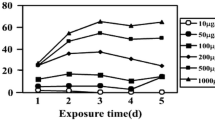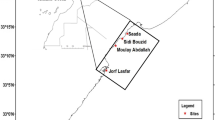Abstract
Enrichment of selenium (Se) by seaweed is of great significance for mariculture. In this study, the green alga Ulva fasciata was cultured with a selenite (Na2SeO3) concentration from 0 to 1,250 mg L−1. Se accumulation in the algal biomass was linearly related to Na2SeO3 concentration in the culture medium. Lower Se concentrations (≤750 mg L−1) increased the activities of guaiacol peroxidase (GPX), catalase (CAT), peroxidase (POD) and superoxide dismutase (SOD) and the content of photosynthetic pigments, and as well induced lipid peroxidation (LPO) and intracellular reactive oxygen species (ROS) levels. Meanwhile, the cell growth rate and concentrations of organic Se increased. In contrast, these changes were the opposite in U. fasciata exposed to Se concentrations higher than 750 mg L−1. In all cases, Se-Ulva was able to remove inorganic nutrients effectively. Therefore, U. fasciata is tolerant to Se, and Se-Ulva has potential as a source of antioxidative food and an effective control of eutrophication.






Similar content being viewed by others
References
Abdel-Hamid MI, Skulberg OM (2006) Effect of selenium on the growth of some selected green and blue-green algae. Lakes Reserv Res Manag 1:205–211
Bradford MM (1976) A rapid and sensitive method for the quantitation of microgram quantities of protein utilizing the principles of protein–dye binding. Anal Biochem 72:248–254
Buege JA, Aust SD (1978) Microsomal lipid peroxidation. Methods Enzymol 52:302–306
Candan N, Tarhan L (2003) Relationship among chlorophyll-carotenoid concentration, antioxidant enzyme activities and lipid peroxidation levels by Mg2+ deficiency in the Mentha pulegium leaves. Plant Physiol Biochem 41:35–40
Chapman PM, Adams WJ, Brooks M, Delos CG, Luoma SN, Maher WA, Ohlendorf HM, Presser TS, Shaw P (2010) Ecological assessment of selenium in the aquatic environment. CRC Press Inc, London
Chen TF, Zheng WJ, Wong YS, Yang F (2008) selenium-induced changes in activities of antioxidant enzymes and content of photosynthetic pigments in Spirulina platensis. J Integr Plant Biol 50:40–48
Combs GF Jr (2000) Food system-based approaches to improving micronutrient nutrition. Biofactors 12:39–43
De Alcantara S, Lopes CC, Wagener K (1998) Controlled introduction of selenium into Chlorella cells. Indian J Exp Biol 36:1286–1288
De Vos CHR, Schat H, Vooijs R, Ernst WHO (1989) Copper-induced damage to the permeability barrier in roots of Silene cucubalus. J Plant Physiol 135:164–169
Demmig-Adams B (1990) Carotenoids and photoprotection in plants: a role for the xanthophyll zeaxanthin. Biochim Biophys Acta 1020:1–24
Donahue JL, Okpodu CM, Cramer CL, Grabau EA, Alscher RG (1997) Responses of antioxidant to paraquat in pea leaves. Plant Physiol 113:249–257
Drake EN (2006) Cancer chemoprevention: selenium as a prooxidant, not an antioxidant. Med Hypotheses 67:318–322
Duan XJ, Zhang WW, Li XM, Wang BG (2006) Evaluation of antioxidant property of extract and fractions obtained from a red alga Polysiphonia urceolata. Food Chem 95:37–43
Fan TWM, Teh SJ, Hinton DE, Higashi RM (2002) Selenium biotransformations into proteinaceous forms by foodweb organisms of selenium-laden drainage waters in California. Aquat Toxicol 57:65–84
Fei XG (2004) Solving the coastal eutrophication problem by large scale seaweed cultivation. Hydrobiologia 512:145–151
Fleurence J (1999) Seaweed proteins: biochemical, nutritional aspects and potential uses. Trends Food Sci Technol 10:25–28
Flohé L, Günzler WA (1984) Assays of glutathione peroxidase. Methods Enzymol 105:114–121
Fournier E, Adam-Guillermin C, Potin-Gautier M, Pannier F (2010) Selenate bioaccumulation and toxicity in Chlamydomonas reinhardtii: influence of ambient sulphate ion concentration. Aquat Toxicol 97:51–57
Foyer CH, Lelandais M, Kunert KJ (1994) Photooxidative stress in plants. Physiol Plant 92:696–717
Fu LH, Wang XF, Eyal Y, She YM, Donald LJ, Standing KG, Ben-Hayyim G (2002) A selenoprotein in the plant kingdom mass spectrometry confirms that an opal codon (UGA) encodes selenocysteine in Chlamydomonas reinhardtii glutathione peroxidase. J Biol Chem 227:25983–25991
Halliwell B, Gutteridge JMC (1999) Free radicals in biology and medicine. Clarendon Press, Oxford
Harrison PJ, Yu PW, Thompson PA, Price NM, Philips DJ (1988) Survey of selenium requirements in marine phytoplankton. Mar Ecol Prog Ser 47:89–96
Imlay JA, Linn S (1998) DNA damage and oxygen radical toxicity. Science 240:1302–1309
Kuda T, Tsunekawa M, Hishi T, Araki Y (2005) Antioxidant properties of dried kayamo-nori, a brown alga Scytosiphon lomentaria (Scytosiphonales, Phaeophyceae). Food Chem 89:617–622
Lee WY, Wang WX (2001) Metal accumulation in the green macroalga Ulva fasciata: effects of nitrate, ammonium and phosphate. Sci Total Environ 278:11–22
Li ZY, Guo SY, Li L (2003) Bioeffects of selenite on the growth of Spirulina platensis and its biotransformation. Bioresour Technol 89:171–176
Mager WH, De-Kruijff AJ (1995) Stress-induced transcriptional activation. Microbiol Mol Biol Rev 59:506–531
McVey JP, Stickney RR, Yarish C, Chopin T (2002) Aquatic polyculture and balanced ecosystem management: new paradigms for seaweed production. In: Stickney RR, Mcvey JP (eds) Responsible marine aquaculture. CABI Publishing, Wallingford, pp 91–104
Novoselov SV, Rao M, Onoshko NV, Zhi H, Kryukov GV, Xiang Y, Weeks DP, Hatfield DL, Gladyshev VN (2002) Selenoproteins and selenocysteine insertion system in the model plant cell system, Chlamydomonas reinhardtii. EMBO J 21:3681–3693
Okamoto OK, Colepicolo P (1998) Response of superoxide dismutase to pollutant metal stress in the marine dinoflagellate Gonyaulax polyedra. Comp Biochem Physiol 119:67–73
Pilon-Smits EAH, LeDuc DL (2009) Phytoremediation of selenium using transgenic plants. Curr Opin Biotechnol 20:207–212
Pilon-Smits EAH, Quinn CF, Tapken W, Malagoli M, Schiavon M (2009) Physiological functions of beneficial elements. Curr Opin Plant Biol 12:267–274
Plant JA, Kinniburgh DG, Smedley PL, Fordyce FM, Klinck BA (2004) Arsenic and selenium. In: Lollar BS (ed) Treatise on geochemistry, vol. 9, environmental geochemistry. Elsevier, UK, pp 17–66
Price NM, Thompson PA, Harrison PJ (1987) Selenium: an essential element for growth of the coastal marine diatom Thalassiosira pseudonana. J Phycol 23:1–9
Pronina NA, Kovshova YI, Popova VV, Lapin AB, Alekseeva SG, Baum RF, Mishina IM, Tsoglin LN (2002) The effect of selenite ions on growth and selenium accumulation in Spirulina platensis. Russ J Plant Physiol 49:235–241
Pyrzynska K (1998) Speciation of selenium compounds. Anal Sci 14:479–483
Reunova YA, Aizdaicher NA, Khristoforova NK, Reunova AA (2007) Effects of selenium on growth and ultrastructure of the marine unicellular alga Dunaliella salina (Chlorophyta). Russ J Mar Biol 33:125–132
Saito Y, Yoshida Y, Akazawa T, Takahashi K, Niki E (2003) Cell death caused by selenium deficiency and protective effect of antioxidants. J Biol Chem 278:39428–39434
Salin ML, Day ED Jr, Crapo JD (1978) Isolation and characterization of a manganese-containing superoxide dismutase from rat liver. Arch Biochem Biophys 187:223–228
Schiavon M, Moro I, Pilon-Smits EAH, Matozzo V, Malagoli M, Dalla Vecchia F (2012) Accumulation of selenium in Ulva sp. and effects on morphology, ultrastructure and antioxidant enzymes and metabolites. Aquat Toxicol 122:222–231
Spallholz JE (1994) On the nature of selenium toxicity and carcinostatic activity. Free Radic Biol Med 17:45–64
Thomas H, Ougham H, Hortensteiner S (2001) Recent advances in the cell biology of chlorophyll catabolism. Adv Bot Res 35:1–52
Trigona WL, Mullarky IK, Cao Y, Sordillo LM (2006) Thioredoxin reductase regulates the induction of haem oxygenase 1 expression in aortic endothelial cells. Biochem J 394:207–216
Troell M, Ronnback P, Halling C, Kautsky N, Buschmann A (1999) Ecological engineering in aquaculture: use of seaweeds for removing nutrients from intensive mariculture. J Appl Phycol 11:89–97
Umysová D, Vítová M, Doušková I, Bišová K, Hlavová M, Čížková M, Machát J, Doucha J, Zachleder V (2009) Bioaccumulation and toxicity of selenium compounds in the green alga Scenedesmus quadricauda. BMC Plant Biol 9:58–74
Wang DZ, Cheng ZD, Li SJ, Gao YH (2003) Toxicity and accumulation of selenite in four microalgae. Chin J Oceanol Limnol 21:280–285
Wellburn AR (1994) The spectral determination of chlorophylls a and b, as well as total carotenoids, using various solvents with spectrophotometers of different resolution. J Plant Physiol 144:307–313
Wheeler AE, Zingaro RA, Irgolic K (1982) The effects of selenate, selenite and sulphate on the growth of six unicellular marine algae. J Exp Mar Biol Ecol 57:181–194
Wong D, Oliveira L (1991) Effects of selenite and selenate toxicity on the ultrastructure and physiology of three species of marine microalgae. Can J Fish Aquat Sci 48:1201–1211
Yamaoka Y, Takimura O, Fuse H (1994) Effects of various elements on arsenic accumulation of the alga Dunaliella salina. Appl Organomet Chem 8:229–235
Yang YF, Li CH, Nie XP, Tang DL, Chung IK (2004) Development of mariculture and its impacts in Chinese coastal waters. Rev Fish Biol Fish 14:1–10
Zhang Q, Yu P, Li Z, Zhang H, Xu Z, Li P (2003) Antioxidant activities of sulfated polysaccharide fractions from Porphyra haitanesis. J Appl Phycol 15:305–310
Zhang L, Ackley AR, Pilon-Smits EAH (2007) Variation in selenium tolerance and accumulation among 19 Arabidopsis thaliana accessions. J Plant Physiol 164:327–336
Zhu YG, Pilon-Smits EAH, Zhao FJ, Williams PN, Meharg AA (2009) Selenium in higher plants: understanding mechanisms for biofortification and phytoremediation. Trends Plant Sci 14:436–442
Acknowledgments
This work was supported by the National Key Technology R&D Program of China (2012BAC07B05), Special Fund for Agro-scientific Research in the Public Interest in China (201403008) and the Natural Science Foundation of China (Grant No. U1301235, 41173079).
Author information
Authors and Affiliations
Corresponding author
Rights and permissions
About this article
Cite this article
Zhong, Y., Chen, T., Zheng, W. et al. Selenium enhances antioxidant activity and photosynthesis in Ulva fasciata . J Appl Phycol 27, 555–562 (2015). https://doi.org/10.1007/s10811-014-0350-2
Received:
Revised:
Accepted:
Published:
Issue Date:
DOI: https://doi.org/10.1007/s10811-014-0350-2




